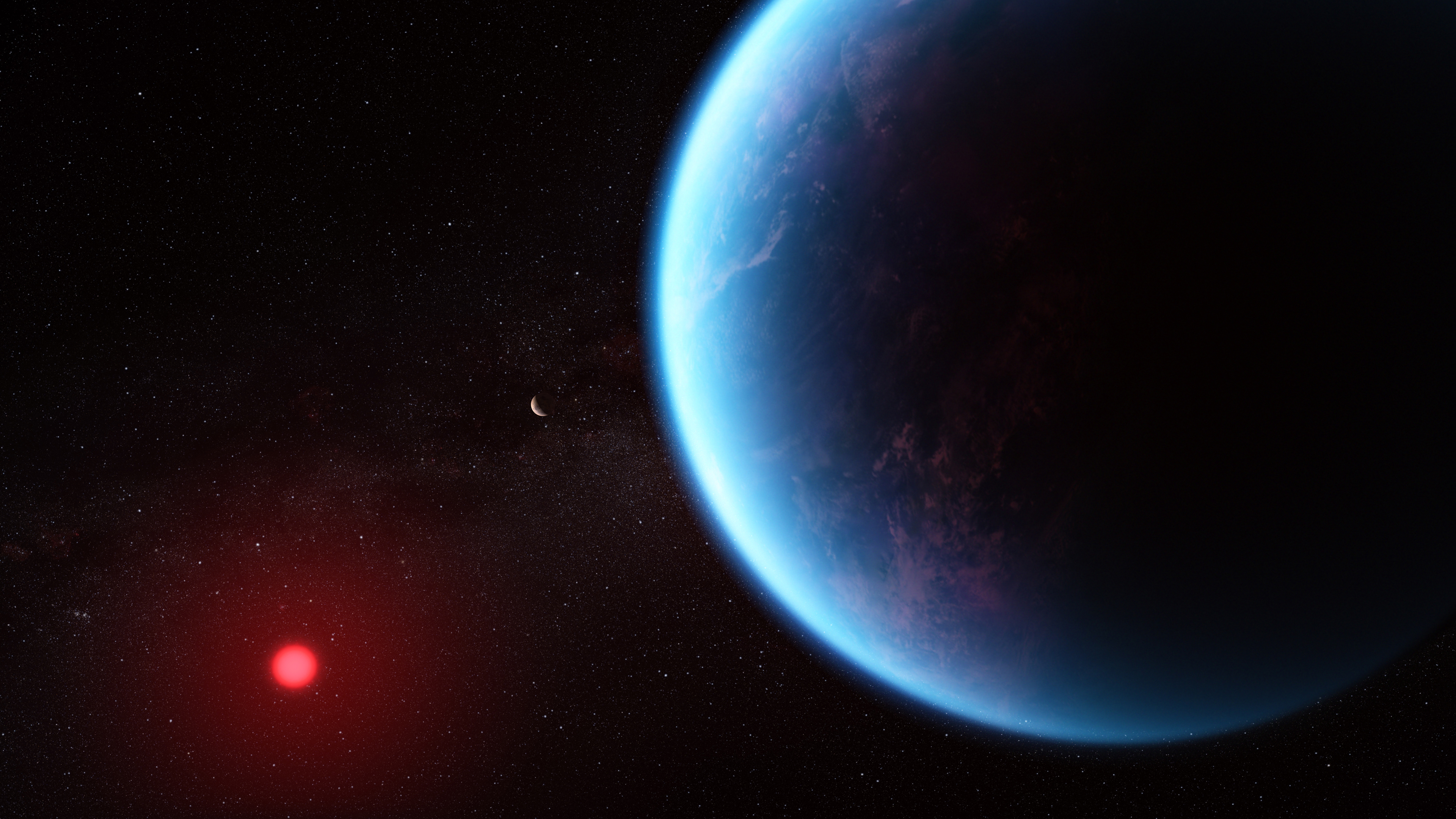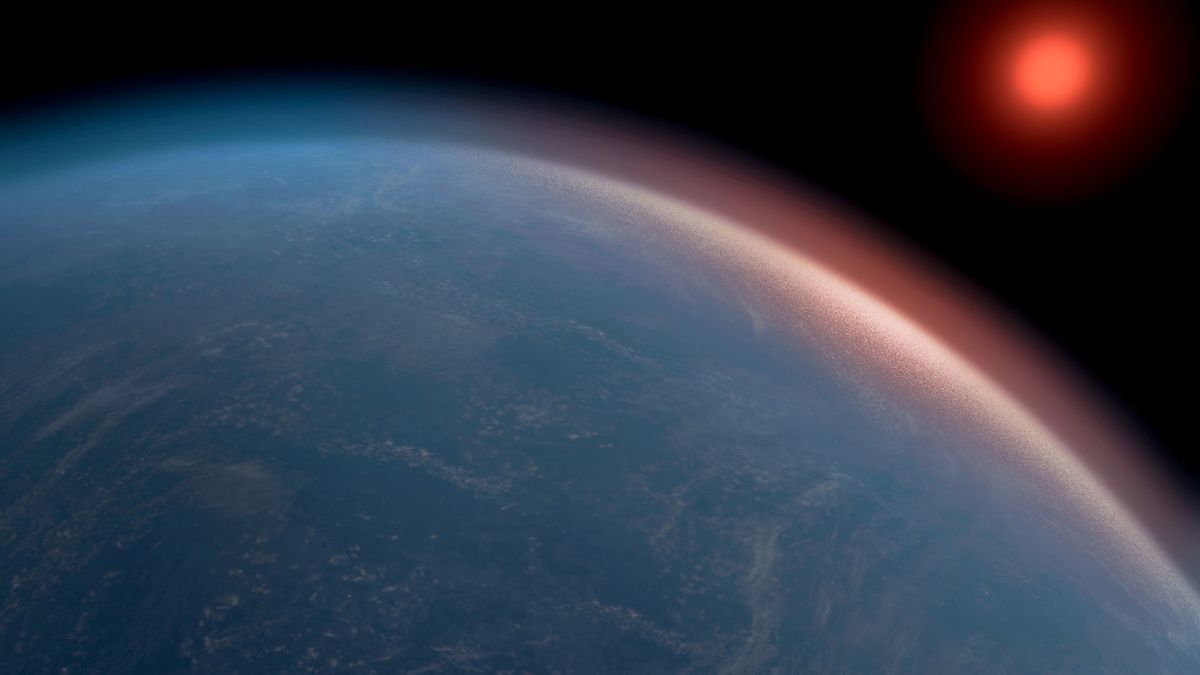Alien or Life
In the hunt for alien life, this planet just became a top suspect
The mixture of gasses measured in exoplanet K2-18 b suggests it may have a global ocean beneath a hydrogen-rich atmosphere—and astronomers even spotted a tantalizing, though unconfirmed, sign of life.

Recent observations made by the James Webb Space Telescope have revealed new details of the atmosphere of a distant planet called K2-18 b. An analysis by a European team of researchers found an abundance of methane and carbon dioxide with very little ammonia—a combination that suggests the world could be a type of oceanic planet, previously only theorized.
K2-18b is located at the correct distance from its star that life is considered possible—and the new analysis suggests another compound, dimethyl sulfide, which is made by life on Earth, may also be in this watery world’s atmosphere. Follow-up observations will attempt to determine if the compound is really there, and if it is present, additional work would be needed to rule out possible non-living sources of the gas.
Even without life, K2-18b is helping reveal a whole new class of worlds that are bigger than Earth but smaller than Neptune. Nikku Madhusudhan, an astronomer at the University of Cambridge and lead author of the paper announcing the results, previously theorized that such planets could host liquid oceans beneath their atmospheres.
He recalls seeing the data that showed the presence of hydrogen and, even more revealing, methane and a lack of ammonia. Research suggests a large planet like K2-18 b could only have that ratio of gasses if the atmosphere were interacting with water below.
“We’d been looking for methane in these low temperature atmospheres for a decade, and here we found it on the first transit,” he says. “It was a eureka moment.”
In 2021 Madhusudhan coined the word for these wet planets: Hycean worlds. It sounds romantic, but he just combined hydrogen and ocean in a portmanteau. In addition to being an intriguing type of planet we don’t have in the solar system, these worlds are pragmatic to study: They are larger than rocky worlds, making it easier for a space telescope to measure them with remote sensors.

The Webb telescope scanned the planet during a pair of 2.5-hour transits in front of its host star in January and April. The onboard instruments scrutinized the starlight passing through the planet’s atmosphere, giving astronomers spectral clues that can be used to identify the gasses present.
Webb, with a cost at the time of launch of $10 billion, is proving its worth to researchers as a tool to examine distant planets. Madhusudhan says one five-hour transit observation with Webb provides more data than eight combined observations with the Hubble Space Telescope, which would take years to accomplish. “It’s revolutionary,” he says.
Where to look for life
There are two prominent schools of thought in the ranks of those hunting for alien life on exoplanets—those who expect to find it on a rocky world, like Earth, and those who want to search worlds dominated by oceans.

The new study provides tantalizing new clues about possible ocean worlds, and Webb has also turned its gaze to rocky targets. Earlier this year the telescope observed the nearby, Earth-size planets TRAPPIST-1 b and TRAPPIST-1 c, revealing that they are probably bare rock without protective atmospheres of CO2, making life unlikely. The findings suggest rocky planets such as these, which orbit a type of cool dwarf star known for giving off flares, may not be suitable environments for living organisms.
“It is extraordinary that we can measure this,” said Laura Kreidberg of the Max Planck Institute for Astronomy, one of the scientists who studied the TRAPPIST-1 system, in a statement. “There have been questions for decades now about whether rocky planets can keep atmospheres. Webb’s ability really brings us into a regime where we can start to compare exoplanet systems to our solar system in a way that we never have before.”
While the new study strengthens the case for the existence of Hycean worlds, there are still alternative explanations. The same data from Webb can produce slightly different results depending on how the analysis is done, which scientists sometimes refer to as the “data analysis pipeline.”
“Folks have already shown that the retrieved abundances from JWST can be very pipeline dependent,” says Sarah Hörst, a planetary scientist at John Hopkins University who specializes in atmospheric chemistry and was not part of the new study. “Calculations required to make such a claim are highly sensitive to the amount of various molecules in the atmosphere.”
Madhusudhan agrees that more work needs to be done to confirm the results and says that a team from NASA’s Jet Propulsion Laboratory has time reserved to scan the planet with JWST later this year to gather more data. “This is the start of a long road,” he says. “But an exciting one.”
Ocean planet extraterrestrials?
Water-rich planets like K2-18 b are good candidates in the search for alien life—after all, it’s the medium that enabled Earth to flourish. But even a planet with a liquid ocean and carbon-rich atmosphere isn’t guaranteed to host organisms—it has to be the right size, temperature, and distance from its sun, in what scientists call “the habitable zone.”
The Atmospheric Characterization of Exoplanet K2-18b
K2-18 b orbits a cool dwarf star in the constellation Leo, a place in space that fits all the habitable zone criteria. But the planet’s large size—8.6 times Earth’s mass—may work against life. Its icy interior may be wrapped with a thin ocean and atmosphere, so the liquid water may be boiling away into space, possibly thwarting the ambitions of any aspiring lifeforms.
But there is another clue in the Webb data—the possible presence of the molecule dimethyl sulphide. You find DMS in Earth’s atmosphere, produced by swarms of phytoplankton in the oceans. It’s also the compound that makes a German-style lager smell so pungent.
As exciting as the possibility of this molecule on another planet is, there is a long way to go before scientists know for sure. “It doesn’t really seem like there is compelling evidence for DMS in their data,” Hörst says.
Mid-InfraRed Instrument (MIRI), a spectrograph that’s optimized to detect DMS, to confirm or disprove its presence. “Ask me this time next year,” he says of the expected timing of the MIRI results.
On Earth, no process is known to create DMS molecules but oceanic life. However, on a world like K2-18 b the conditions might be right for abiotic, non-living sources. “Our understanding of sulfur-bearing chemistry is very Earth- and Venus-centric, which are very different atmospheres from a hydrogen-dominated atmosphere [like K2-18’s],” Hörst says. “We need many more theoretical calculations and laboratory measurements to understand what the different possible pathways are for creating and destroying DMS in an atmosphere.”
If DMS is detected on K2-18 b, “it’s time for the theorists to really get involved,” Madhusudhan says. Their job will be to run countless simulations of the planet’s chemistry during its lifespan, trying to detect any possible pathway that would create the signatures JWST found without the presence of life. “We don’t have to prove it’s a biomarker, because it is one on Earth,” Madhusudhan says. Only once no other explanation is found can the case for a living ocean on the planet be made.
The proof of alien life is often depicted with the discovery of a Martian fossil, the receipt of an interstellar transmission, or even a verified extraterrestrial visitation to the White House lawn. But the actual moment that humanity finds out that we’re not alone may be experienced by a solitary data cruncher, seated in front of a computer screen running complex organic chemistry models.
Source
https://tr.wikipedia.org/wiki/K2-18b
https://www.nasa.gov/universe/exoplanets/webb-discovers-methane-carbon-dioxide-in-atmosphere-of-k2-18-b/
https://exoplanets.nasa.gov/exoplanet-catalog/4847/k2-18-b/
https://www.explore-exoplanets.eu/resource/k2-18b/
https://exoplanetarchive.ipac.caltech.edu/overview/K2-18
https://www.esa.int/Science_Exploration/Space_Science/Webb/Webb_discovers_methane_and_carbon_dioxide_in_atmosphere_of_K2-18_b
https://exoplanet.eu/catalog/k2_18_b--3953/
https://www.nationalgeographic.com/premium/article/hunt-for-alien-life-exoplanet-just-became-top-suspect






































































